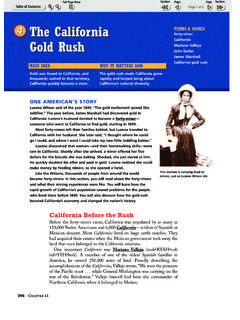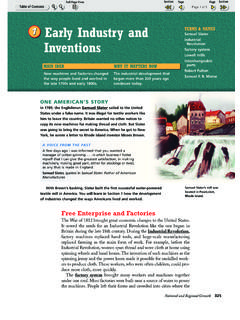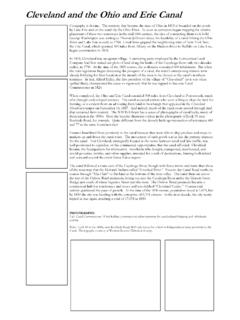Transcription of 3 Nationalism and Sectionalism - Mr Thompson's Classroom
1 338 CHAPTER1133 Nationalism and SectionalismNationalism and SectionalismTERMS & NAMES nationalismHenry ClayAmerican SystemErie CanalJames MonroesectionalismMissouriCompromiseMonr oe DoctrineONE AMERICAN S STORYIn the early 1800s, as you have read, the North began to industrializeand the South relied more heavily on growing cotton. At the sametime, a rising sense of Nationalism pulled people from different regionstogether. Nationalismis a feeling of pride, loyalty, and protectivenesstoward your country. The War of 1812 sent a wave of nationalistfeeling through the United States. Representative Henry Clay, from Kentucky, was a strongnationalist. After the war, President James Madison supported Clay splan to strengthen the country and unify its different VOICE FROM THE PASTE very nation should anxiously endeavor to establish its absoluteindependence, and consequently be able to feed and clothe anddefend itself.
2 If it rely upon a foreign supply that may be cut off .. it cannot be Clay, quoted in The Annals of AmericaIn this section, you will learn how Nationalism affected growth and foreign policy. You ll also see how Americanswere beginning to be torn between the interests of their own regionsand those of the country as a Unites the CountryIn 1815, President Madison presented a plan to Congress for makingthe United States economically self-sufficient. In other words, thecountry would prosper and grow by itself, without foreign products orforeign plan which Henry Clay promoted as the American System included three main Establish a protective tariff,a tax on imported goods that protectsa nation s businesses from foreign competition. Congress passed atariff in 1816. It made European goods more expensive and en-couraged Americans to buy cheaper American-made pride united the states, but tension between the North and South tension led to the Civil War, andregional differences can still befound in the United States IDEAWHY IT MATTERS NOWH enry Clay338-343US8P R U3C11S3 11/26/02 2:46 PM Page 3382.
3 Establish a national bank that would promote a single currency,making trade easier. (Most regional banks issued their own money.)In 1816, Congress set up the second Bank of the United Improve the country s transportation systems, which were im-portant for a strong economy. Poor roads made transportation slowand and Canals Link CitiesRepresentative John C. Calhoun of South Carolina also called for bet-ter transportation systems. Let us bind the Republic together with aperfect system of roads and canals, he declared in 1817. Earlier, in1806, Congress had funded a road from Cumberland, Maryland, toWheeling, Virginia. By 1841, the National Road, designed as the coun-try s main east-west route, had been extended to Vandalia, transportation improved, too, with the building of canals.
4 Infact, the period from 1825 to 1850 is often called the Age of in 1825, the massive Erie Canalcreated a water routebetween New York City and Buffalo, New York. The canal opened theupper Ohio Valley and the Great Lakes region to settlement and also fueled Nationalism by unifying these two sections of the Erie canal allowed farm products from the Great Lakes regionto flow east and people and manufactured goods from the East to flowCanalNational Road00200 Miles400 Kilometers 35 N40 N65 W70 W75 W80 W85 W90 WNational(Cumberland)RoadMiami andErie CanalChamplainCanalOhio andErie canal Chesapeake andOhio CanalPennsylvaniaCanalErieCanalRichmondC umberlandWheelingPittsburghBuffaloNew YorkCANADAA lbanyClevelandToledoChicagoLa OCEANLakeChamplainLakeHuronMajor Canals, 1840339 GEOGRAPHY SKILLBUILDERI nterpreting Maps1.
5 MovementBy what water route could goods fromCleveland reach New York City?2. RegionWhich region benefited more from canals the North or the South?A. RecognizingEffectsHowwould the threeparts of theAmerican Systemhelp to make the country self-sufficient?A. AnswerA tar-iff would protectbusinesses; anational bank and improvedtransportationwould makeinternal trade route includ-ing Lake Erie, theErie canal , andthe Hudson NorthThe Erie canal was 4 feet deep, 40 feet wide, and360 miles R U3C11S3 11/26/02 2:46 PM Page 339west. Trade stimulated by the canal helped New York City become thenation s largest city. Between 1820 and 1830, its population swelled fromless than 125,000 to more than 200, the 1830s, the nation began to use steam-powered trains fortransportation. In 1830, only about 30 miles of track existed in theUnited States.
6 But by 1850, the number had climbed to 9,000 in rail travel led to a decline in the use of Era of Good FeelingsAs nationalist feelings spread, people slowly shifted their loyaltyaway from state governments and more toward the federalgovernment. Democratic-Republican James Monroewonthe presidency in 1816 with a large majority of electoralvotes. The Federalist Party provided little opposition toMonroe and soon disappeared. Political differences gaveway to what one Boston newspaper called the Era ofGood the Monroe administration, several landmarkSupreme Court decisions promoted national unity bystrengthening the federal government. For example, inMcCulloch (1819), the state of Marylandwanted to tax its branch of the national bank. If this taxwere allowed, the states could claim to have power over thefederal government.
7 The Court upheld federal authority by ruling that a state could not tax a national VOICE FROM THE PASTThe States have no power, by taxation or otherwise, to retard, impede,burden, or in any manner control the operations of the constitutional lawsenacted by Justice John Marshall, McCulloch v. Maryland (1819)Another Court decision that strengthened the federal governmentwas Gibbons (1824). Two steamship operators fought over ship-ping rights on the Hudson River in New York and New Jersey. TheCourt ruled that interstate commerce could be regulated only by the fed-eral government, not the state Supreme Court under John Marshall clearly stated importantpowers of the federal government. A stronger federal governmentreflected a growing nationalist National BoundariesThis nationalist spirit also made leaders want to define and expandthe country s borders.
8 To do this, they had to reach agreements withBritain and agreements improved relations between the United States andBritain. The Rush-Bagot Agreement (1817) limited each side s naval340 CHAPTER11 BackgroundMaryland alsoargued thatCongress had nopower to createthe bank, butthe Court ruledthat it did havesuch Finding MainIdeasHow didthe SupremeCourt strengthenthe federal government? B. AnswerBy ruling that statescould not inter-fere with federallaws and thatonly the federalgovernment couldregulate inter-state Monroe338-343US8P R U3C11S3 11/26/02 2:46 PM Page 340forces on the Great Lakes. In the Convention of 1818, the two coun-tries set the 49th parallel as the border as far west as theRocky relations with Spain were tense. The two nations disagreedon the boundaries of the Louisiana Purchase and the ownership of WestFlorida.
9 Meanwhile, pirates and runaway slaves used Spanish-held EastFlorida as a refuge. In addition, the Seminoles of East Florida raidedwhite settlements in Georgia to reclaim lost 1817, President Monroe ordered General Andrew Jackson to stopthe Seminole raids, but not to confront the Spanish. Jackson followedthe Seminoles into Spanish territory and then claimed the Floridas forthe United ordered Jackson to withdraw but gave Spain a choice. It couldeither police the Floridas or turn them over to the United States. In theAdams-On s Treaty of 1819, Spain handed Florida to the United Statesand gave up claims to the Oregon Country. The map above showsboundaries drawn and territories gained in 1818 and Tensions IncreaseAt the same time Nationalism was unifying the country, Sectionalism wasthreatening to drive it loyalty to the interests ofyour own region or section of the country, rather than to the nation as awhole.
10 Economic changes had created some divisions within the UnitedStates. As you have seen, white Southerners were relying more on cottonand slavery. In the Northeast, wealth was based on manufacturing andtrade. In the West, settlers wanted cheap land and good interests of these sections were often in became a major issue when Missouri applied for state-hood in 1817. People living in Missouri wanted to allow slavery in theirstate. At the time, the United States consisted of 11 slave states and 1140 N20 N100 W80 W120 WGulf of MexicoATLANTICOCEANPACIFICOCEANCANADAMEX ICO(NEW SPAIN)OREGONCOUNTRY(claimed by Britain)UNITEDSTATESBRITISH TERRITORYC laimed by BritainFloridaTerritory gained:Adams-On s Treatyof 1819 with Spain(including new southwest border line)Convention of 1818with Great Britain(including new north border line)00500 Miles500 Kilometers National and Regional Growth341C.







